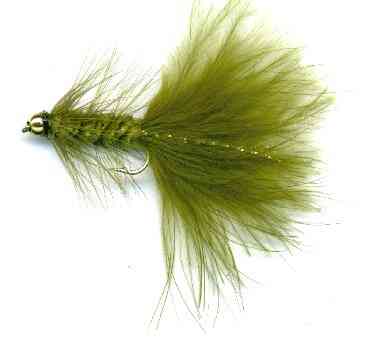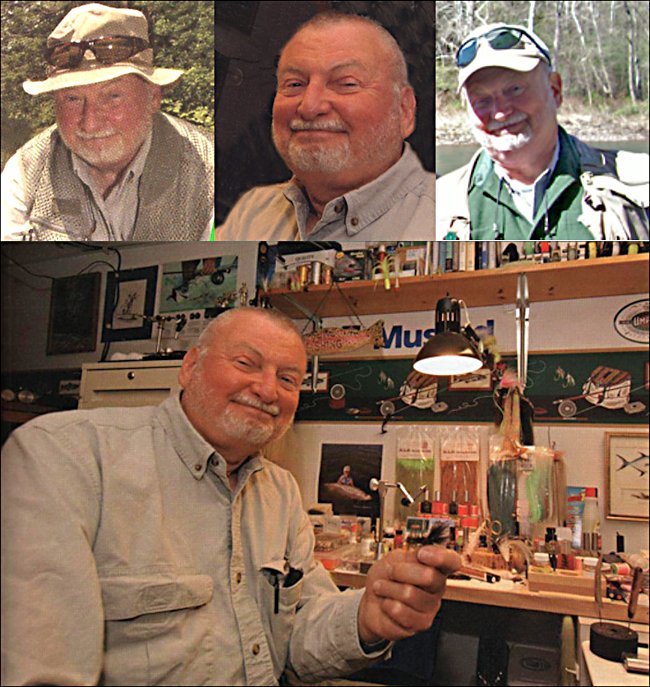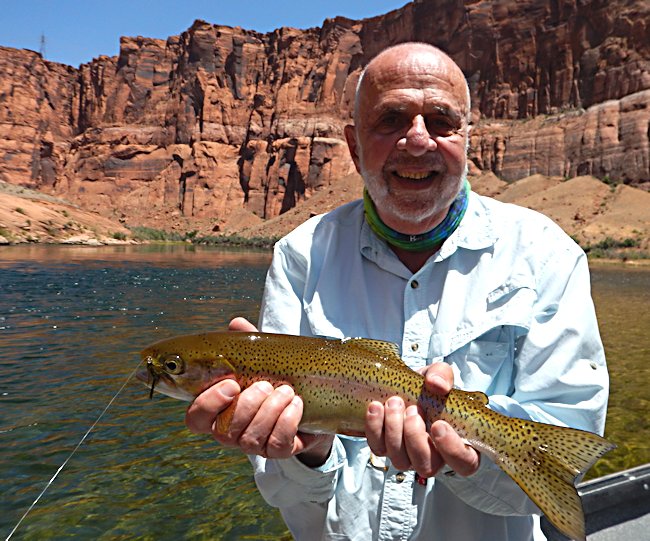The Beaded Olive Woolly Bugger Fly
The Woolly Bugger fishing fly pattern has to be one of the most versatile and productive flies around. The marabou tail and in most cases a palmered body suggest succulent small juvenile bait fish, insect larva, tadpoles or leeches that trout, bass and steelhead devour

WOOLLY BUGGER STREAMER FLY PATTERN. Hook size 10 4 2 - $US each
OLIVE DAMSEL NYMPHS
The Olive Damsel nymph is looked for by trout feeding on the real insects making their way to the surface. Unlike a mayfly or caddis nymph these insects hatch out of the water not on it. They crawl out onto the shore or up any nearby vegetation. They will also crawl up a fisherman’s waders.
As soon as the sun is well up, the damsel nymphs start their trek along the river or lake bottom. They can be seen crawling on top of weed-beds towards the shore. As soon as they reach it they crawl up anything they can find to get clear of the water. When they are in a dry location they hatch from their nymphal skin.
It is during this trek to the shore that the trout and grayling feed on them and continue to do so even as they are starting their crawl out of the water. I have even had a trout take damsel fly nymphs that were crawling up my waders. As they climb and crawl towards they surface they move in a wriggling motion.
GOLD BEAD HEAD FLIES
The gold colored beads add weight to a fly. It helps when you need to fish a fly on or near the river bottom. Because the bead is at the front of the fly it is this section that dives to the river floor first when the line is paused on the retrieve. After casting the fly try retrieve, pause, retrieve, pause. This helps animate the fly and makes them more attractive to the trout. If a sunbeam shines through the water it will reflect off the shinny gold bead head surface and hopefully help in catching the eye of a predatory trout. I prefer gold colored beads as I believe your chances of a fish taking your fly are improved. Many classic patterns have gold bead head variations. Have fun. Have a great day. Go fly fishing!.
WOOLLY BUGGER STREAMERS
Drag a Woolly Bugger across the current in front of some trout and this fly becomes a killer. We have added additional flash to improve there performance. From experience it helps catch the eye of a predatory trout or salmon when the flash in the tail reflects a quick glint of sunlight as the marabou tail moves through the water. It is a great modern streamer pattern and appears in many colors and hook sizes. You can use it for bass, trout or panfish as well. It's a great fly, and every flybox should contain several. You fish it like a streamer. This fly's colorful name and the gnarly way it looks can be deceiving. This is a big fish fly, perhaps the very best big fish fly in use currently. The Woolly Bugger has a lively marabou feather tail that "breathes" in the water and looks lively to hungry trout. Dressing a fly by winding the hackle the length of the body is mentioned in fly fishing books of the fifteenth century. It is called the palmer style of dressing. About the time Napoleon was fighting the British in France and Spain, palmer flies were being praised in books as the first fly to be used until a hatch was observed. The palmered hackle helps suggest to the trout that the fly is alive by its movement.
A Harrisburg, Pennsylvania fly tier, Russell Blessing tied the first "Buggers". He added a marabou tail to a woolly worm fly, to help suggest a swimming movement as the fly was retrieved in the water. He found that even if fished dead-drift the fly still had movement. The woolly worm is a very old fly that can be found in Izaak Walton's 1653 book "The Compleat Angler". Russell's original Woolly Bugger had a black marabou tail, and a black hackled olive chenille body, (just like our Viva Woolly Bugger). He had designed it to fish the small mouth bass in the streams near his home. He had been trying to imitate the dobsonfly lava. Back in 1967 on a hot August afternoon flyfishing journalist Barry Beck was having a hard time getting the fish to bite on the Little Lehigh River in Pennsylvania, USA. Other flyfishermen nearby were also having the same problem, that is all except one, Russ Blessing. In a 30 minute period he netted four nice trout. Barry went over and asked what fly he was using. Barry was shocked to find it was a streamer. This type of fly normally was not very productive on the Lehigh River and especially in August. Russ, a true gentleman fly fisherman who was always willing to share his knowledge of fly-fishing and fly-tying gave Barry one of his Woolly Buggers to try. Barry's luck changed and he started to catch trout. Barry was so impressed that when he met Russ in the parking area just as he was going home he asked for more information about the fly.

This is fly fisherman Russell Blessing, the designer of the original Woolly Bugger Fly Pattern
Barry published an article on Russell Blessing's wondrous Woolly Bugger in 1984. The rest is history. It became so popular that it is now an American standby. Woolly Buggers catch trout, bass, and salmon in both Atlantic and Pacific rivers, steelhead, Arctic char, northern pike, bluegills and even carp. It would not be an exaggeration to say that there is hardly a fish that swims that could not be caught with a Woolly Bugger. This wide-ranging success is due to the fact that these flies can be used to imitate a variety of fish food forms, including baitfish, crustaceans, insect nymphs salamanders and leeches. To achieve this chameleon status, Woolly Buggers are tied in green, red, olive, gray, grizzly, brown, black, yellow, white, and purple and in all combinations of these colors. This fly can be fished near the surface, or with the addition of weight it is often fished deep. Obviously the Woolly Bugger may not be a glamorous fly, but it deserves to be in everyone's fly box for all kinds of fly fishing, from warmwater to saltwater. Russ Blessing retired in 1996 and when asked what he now did with all his spare time he replied, "I fish".
The Woolly Bugger is a very versatile fly to fish. You can cast it upstream and fish it like a nymph, or cast across a stream and let it drift with the current. A great way to fish streamer flies is to cast across stream, let the current carry it down and across and make stripping retrieves, pulling 6-24" in your fly line, imparting subtle and deliberate action to the fly. The hackle will twitch back over the body and the tail will flare and wiggle supply. This drives fish wild and brings surprising hook ups and many big fish! The word "bugger" is rude in England and described the sex act between to men. Most older traditional English fly tying books do not acknowledge the Woolly Bugger by name, but instead they used to call it wrongly the Woolly Worm or tadpole fly. Modern books now give it it's proper name. In the mid 1980's a fly very similar to the Woolly Bugger became popular in the UK. It was called the Dog Nobbler and was designed and promoted by Trevor Housby. It looks exactly like a woolly bugger except that it had a weighted head.
Fishing the Woolly Bugger is a matter of patience and confidence. Because of the soft saddle hackle rib and the marabou tail, it does not require much action on the part of the angler to give this fly a pulsating, undulating look. In a stream or river, slow to very slow is the key because the current will make it look alive. In a lake, a little more action may be required, but not too much and not too fast. Remember that our Woolly Bugger flies are more superior as they have additional 'flash' added to their tails to get them noticed by predatory trout and salmon.
One of my favorite use of a woolly bugger is for the sport of trying to coax trout that lurk in deep plunge pools to rise up to the surface and take my presentation. They normally will not do so for a dry fly. It has to be a more substantial meal to be worth the effort. I try to imitate a small fish that has been temporally stunned as it swam over the waterfall and landed in the plunge pool. Cast your fly as near to the waterfall as you can. Give it a few moments to sink and then begin the retrieve to imitate the fish recovering and quickly swimming away from it's vulnerable static location to safety. Using the same idea look for deep slow pools near where a stream is forced to drop suddenly due to a narrow rock channel. Small fish will be forced down with the strength of the current before they can quickly swim off to the relative safety of the bank. Drop your streamer into this current and let it sink. Then start you retrieve. Trout can be teased into chasing your fly.
DAMSEL NYMPHS
When you see lots of electric blue damselflies zooming low over the water's surface you know that summer has finally arrived. If you are lucky you may see trout hurling themselves into the air to grab the big flies. Trout mainly eat damsel flies in their aquatic nymph state. Damselflies are related to dragon flies (order Odonata) though they are generally smaller and slimmer. The woolly bugger is an ideal Damsel nymph imitation. Trout will feed on damsel nymphs throughout the year but are more prevalent during late May up till August. The hottest part of the day either side of noon is the best time to see the mass migration of damselfly nymphs on to dry land. During the early part of the season this pattern can be fished very slowly along the bottom. Damsel fly Nymphs like shallow bays where weed is prolific as they feed on decaying vegetable matter. Cast your nymph as close to the weedbeds as possible.
Fish this pattern very slowly along the bottom, to represent the insect stalking prey, but occasionally move it along a small distance at a faster speed. As the fly moves, its marabou tail will wiggle enticingly, just as the real insect's abdomen would do as it swims along. During the warmer months the nymphs are far more active and wriggle to the surface, whereupon they proceed to swim to the shore or towards surface weed in order to hatch into the adult damselflies. As soon as they reach it they crawl up and out of the water. They clamber up anything from an angler’s waders to riverside reeds and rushes. It is during this trek to shore that trout actively feed on them. They even grab them when they are climbing up reeds before hatching. To simulate this activity, fish the fly on a floating line, letting it sink to the bottom before retrieving smoothly so that the fly lifts up in the water towards the surface. Where there are rushes or reeds it is often more productive to cast and retrieve along the shoreline. When they are above the surface level they hatch from their nymphal skin.

CUSTOMER'S PHOTO
This is me at Lees Ferry, Arizona, about a month ago
(May). It’s the tailwater fishery immediately below Glen Canyon Dam on the Colorado River. If you have any interest, you might Google the names John Lee, Lees Ferry, and Lees Ferry Anglers. We had five anglers on the trip, each taking (and releasing!) 50-60 fish a day. This one ate an olive wooly bugger. Bennett J. Mintz CA, USA
CUSTOMER'S COMMENT
Well victory is the beholder a beautiful 7lb rainbow landed at 16.05 this weekend over in Cirencester on a beaded Olive Damsel woolly bugger size 10, stripped through the water like an exocet missile homing in on its target with deadly effect. John Miller
CUSTOMER'S COMMENT
I use big Olive beaded Woolly Buggers on the Little Miami River just south of Dayton in Ohio. They are my most productive streamer especially during the early part of the season. - Stephen Allison


Fly Fishing books

